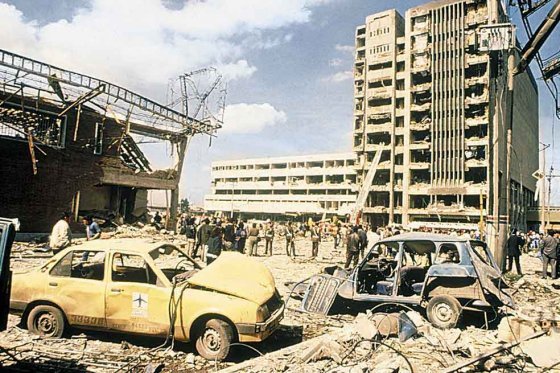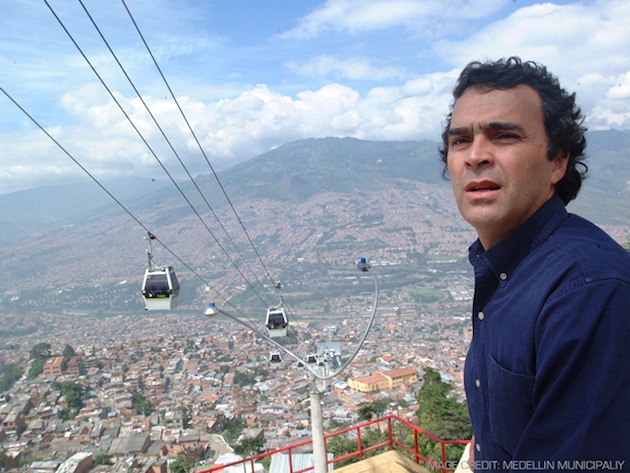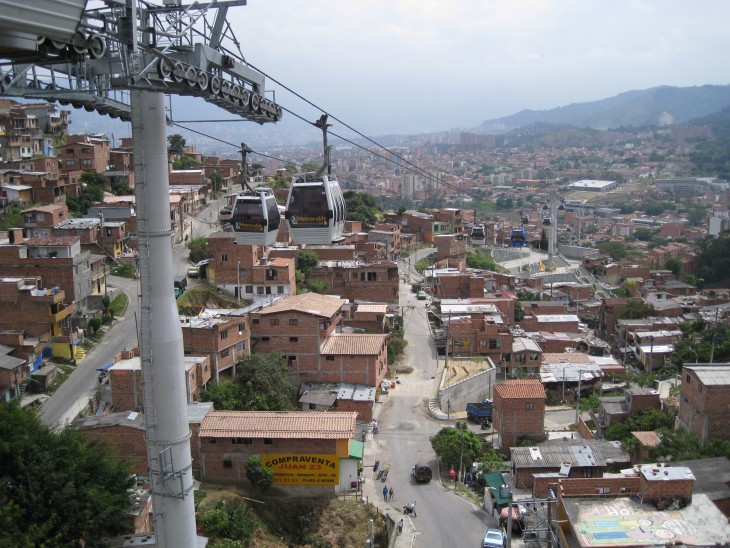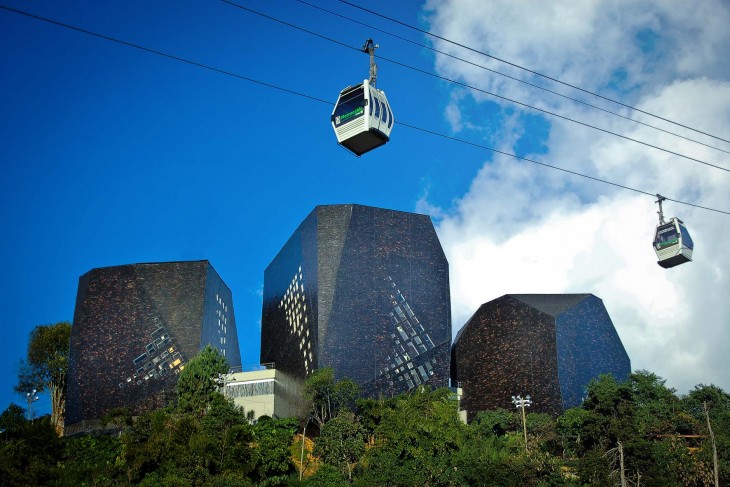MEDELLIN:FROM DRUG CARTELS TO
LATIN AMERICA’S DESIGN
AND ARCHITECTURE HUB.
While Colombia, and most of its main cities are still recovering from the ages of violence and dispair. Medellin, Colombia’s second largest city, has turned into one of Latinamerica’s most admired urban design and architectural hubs. Through the gentifrication of the urban poorest communities,
and under the values of dignity, pride and identity, the city has recovered from the violence years and is turning into one of the prefered cities for colombians to rellocate and start new businesses, as well as a touristic destination for designers, architects and urbanists.

Firstly, it is fair to understand the context of the social and political problems of Medelllin. Being the second largest city of the country, and clearly different in terms of culture and climate from the massive capital Bogota, Medelllin had always remain forgotten and ignored by the biggest and most powerful entities of the country. This obviously lead its inhabitants to start a kind of local and revolutionary proud called Antioquia Federal, a federetion of its department, independent from the Colombian nation. Pablo Escobar, well known drug lord, was also a align with this sort of thinking. Medellin, was in the 1980s and early 1990s, one of the most violent cities in the world. The drug cartel had taken over its most important entities, the police was all corrupted, the streets were run by drug dealers, hit-men or “sicarios”, the cocaine money that flooded from the USA and Europe, was so powerful that Escobar became almost the underground major of the city. He had all sorts of foundations and events to encourage the poor to play sports, he built soccer fields, nourished the poor and shaked hands and kissed babies. Medellin knew of him and the not-so-powerful too. He bought peoples trusts with cocaine money and raised to power. However, the sentiment of proud for the city for the region for the culture was always present. From the people, who proudly would admit that they would die for him, because he was a good man, to the Sicarios who would rather kill their loved ones before turninf their backs to Pablo. Within this context, Medellin became a hell city, the poor, the medium class, and the rich, all suffered equally, one of Colombia s most violent eras. To this day, many of the scars left by the cartel wars are still unhealed. However, it is important to remark, that today s sort of renaissance, was not only based on the good decisions taken by the politians and planners who have been in charge but also, by the great sense of community, love for the city and proud that the Medellin citizens have always had. This feeling has always been present and
socially, Medellin, even in times of drug war and dispair, has always have been characterized by this sense of community proud.

Politically, it is also paramount to understand the changes and context of the city. In 2004, Sergio Fajardo, one of Medellin’s most important figures, started an era of change. Under the anti-corruption laws of controvertial President Alvaro Uribe, who is also from the Medellin region, Fajardo started
changing the city with small but important architectural and urban interventions. Fajardo, who is a mathematitian since 1977, understood the economical context of his mandate as a major. He knew that the budget for public and civil buildings were not compared to the capital Bogota, or to any of Latinamerica’s big cities. However, under these laws, he managed to attrack local architects and urbanists, based either in Bogota or in Medellin, to design and contribute to the cities infrastructure, specially in the poorests and most needed neighbourhoods. Along with his Director of Urban Projects, Alejandro Echeverri, who is an architect also, and inspired by cities like Barcelona, they developed a series of interventions
that would help the city in terms of education, transportation, sport facilities, and security.
As a Colombian, born and raised in thepoor and caothic context of Bogota, as an architect educated in Montreal, one of the most fair and safest cities in the world and through my trips back to my city and around Latinamerica, I have always questioned my work as to how relevant it is and most of the time I have failed to understand this dichotomy of the needed and the wanted, or at least to convey that in my projects. The architect practice, for me, cannot be merely void of anysocial and context. It cannot be divorced from the human, since empty buildings are only good in photographs. In Medellin, the humanitarian and the architects have managed to solve these constant repeling forces to create something that may not be the work of Starchitects or Pritzker price winners, but significant enough to merge the needed and the wanted for the benefit of the user, and that win, small
as it seems, is very important for those who dont have anything. Those who did not have to place to leave their children after school, while they work, and now suddenly have a library, a stadium, a cultural center or any sort of public building to change the community very succesfully. As Fajardo has stated, ‘The first step toward quality education is the dignity of the space. When the poorest kid in Medelling arrives in the best classroom in the city, theres a powerfull message of social inclusion.” And this is the case for all the layers of the social and economical spectrum, the teacher that teaches in this classrooms also feels satisfied and rewarded from teaching in this place. The parents of the kids feel satisfied for having a decent place to have their children educated, and so on. It is this level of dignity that has a great deal of importance in order to gentifricate and renovate a community, especialy in the case of Medellin, where the absence of police forces, the absence of law and order, the absence of legitimate recognition by the polititians has left such a big scar throughout the years of violence. This architectural interventions in Medellin, prove that meaningful design practice can sucessfuly shape an urban vitalization.


Let us explore the main projects that have been developed in Medellin. Firstly, the infrastructure and the change that well designed transportations systems are key for the renovation of conflicted areas. Medellin poorests neighbourhoods are not located in the flat areas of the urban grid. They are called, Comunas, they are big neighbourhoods located up the in hills of the mountains thatsurround Medellin. These neighbourhoods are really hard to access, and the average citizen has to deal with either a long hike to go up and down the mountains or aventure in the chaos of privately managed
bus lines that clog the main steep streets that zigzag front and back towards the mountains. However, and since the instalation of a Metro line that follows the Medellin River, the city has installed a series of gondolas or funiculares called ‘MetroCable’. These mostly connect to the main metro stations located at the bottom of the hills and run constantly to evacuate the high flow of citizens running to work in the mornings and rushing back home up the mountains inthe afternoon. These lines have been so succeseful that the roads now are pretty empty of cars and people have actually
the choice of having nice hike around the neighbourghood or to hop on the funiculares and ride along. Streets are now clearer of traffic and public spaces start to develop, not tohave huge plazas or squares, but streets become a place to be to enjoy, to sit down and eat a snack or to enjoy the view
and not a heavyly circulated mess. Another significant intervention is the Public Park-Library España, situated on top of the hills, in the popular
neighbour of Santo Domingo, this architectural work by Bogota-based architect Giancarlo Mazzanti, overlooks the city from the mountains. The auditorium, library space, training room, are divided in three main volumes that are oustanding in form, color and tectonics from all of its surroundings, the administration and other rooms are all joined at the bottom and its access creates a public square and sort of
belveder to admire the view of the city and become a place of interaction and gathering. This building not only serves the community with books and sports facilities, it also creates a sense of identity and proud. The building itself creates a new landmark for the city, but it is not a church or a soccer stadium, it is not in a rich safe neighbourhood, it is a landmark up in the aire agains the mountain, in one of the poorest areas of the city. The average citizen is clearly indentified with this new typology and not only becomes part of its daily landscape but it most importantly generates feeling of empathy and afection, since they are now part of the most visited places in Medellin and acknowledge but other citizens who identify the place as a local landmark. Mi Biblioteca; Mi Barrio as it can be read on the glass facade of the entrance.
In conclusion, the Medellin example demostrates that the role of the architect and the planner can be succesfull and relevant to the development of a city a region and most importantly a country. Succesful buildings in this case are the ones that integrate with the social context, that establish themselves in the context of reality, they nourish from what people actualy need and feed back to in order to change their condition as citizens. However, it is important to remark, that Medellin is an example of this, because not only the citizens but also the polititians that have taken the dedication and the effort to invest, with smart decision makers, in small interventions and laws that allow architects to develop significant work.
The join effort of these two is key in the Medellin example. Nevertheless, it is always clear that the social condition of the place and its need for design is present in every city and in every scale of the urban context, no matter how small a place is. theres always a need for smart design, and interventions that would allow polititians and communities to improve their environment, even with small but smart effort.
“Medellin – Social change through Architecture and Design” is a project of IaaC, Institute for Advanced Architecture of Catalonia developed at Master in Advanced Architecture in 2016 by:
Students: Jean Sebastian Munera Reyes
Faculty: Gonzalo Delacamara
